There are several factors, discussed in this section, to consider in locating layovers.
Endeavour to minimise negative impacts on local communities while balancing the need to provide layover in a location suitable to meeting operational requirements.
To achieve this:
- Locate layovers near existing toilet facilities where possible.
- Try to avoid positioning layovers close to sensitive land uses, such as houses or businesses which front directly onto the street.
- Where it is difficult to avoid sensitive land uses, identify locations where such buildings are set back from the street or have frontages without windows or entrances.
- The noise from an idling bus engine can cause tensions with nearby property occupiers and therefore drivers should be reminded to turn off their engines whilst at the layover. This could be achieved through signs at the layover or a note in the driver shift cards. Buses with older diesel engines may need to idle for up to two minutes to allow the engine to cool down after which time the engine should be turned off.
- Avoid locating bus layover in a way that is incompatible with known future land use changes including proposed or consented developments.
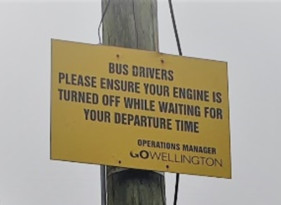
Sign instructing bus drivers at a layover to turn off engines while waiting for their departure time. (Source: Lorelei Schmitt.)
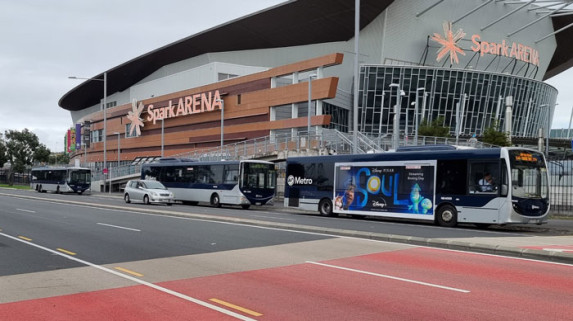
Example of bus layover which is located away from street frontages and does not obstruct driveways from Quay Street, Auckland (Source: Thomas Chu).
The location of bus layover facilities should minimise the opportunity for criminal activity and enhance all elements of security for users and drivers. This is particularly relevant because bus services can operate late into the night and bus drivers may be required to carry cash boxes as part of their job.
Bus layovers should be in areas which:
- are clearly visible with unobstructed sightlines to and from surrounding mixed-use activities or passing pedestrians and motorists
- are well-lit, near street lighting or other sources of illumination
- have the possibility of security cameras to improve surveillance at the location.
The Bus Stop section has more detailed guidance around safety, security and lighting including links to useful resources like lighting standards and more.
Bus Stop safety, security and lighting
The location of bus layovers and driver facilities should not negatively impact on road safety or the efficient operation of the transport network. Consider:
- ‘desire lines’ (direct and desirable routes) for people on foot or bikes so that people do not walk or cycle through the bus layover area
- the walking route between the bus layover space and driver facilities if located apart
- how buses will access the layover and whether turning movements present a hazard to other road users
- whether parked buses or driver facilities will obstruct sight lines for nearby driveways, intersections or crossings
- the wider context of kerb space allocation and land usage, consider relevant competing demands such as parking bays and loading zones.
Layover spaces must not be located directly across driveways or in a way that might inhibit the safe and efficient access of drivers entering or exiting a driveway.
Avoid locating bus layover where vehicles will have to cross the centre line to pass unless vehicle volumes are low and there are clear sightlines for passing vehicles between each end of the layover.
Keep bus movements and parking clear of utilities such as stormwater sump and service covers to avoid disruption to the layover during utility works.
A layover space must not be located in such a way that a parked bus would obstruct a fire hydrant as bus drivers may lock and leave the bus while taking their break which limits emergency service access.
Street furniture clearanceBack to top
Layovers should be located and designed in such a way that street furniture, including but not limited to benches, bus shelters, cycle parking, and signage, is located back from the kerb to ensure adequate clearance to accommodate bus front or rear overhang.
More detail is covered in the Corridor clearance and Bus stop pages:
Corridor Clearance
Bus stop
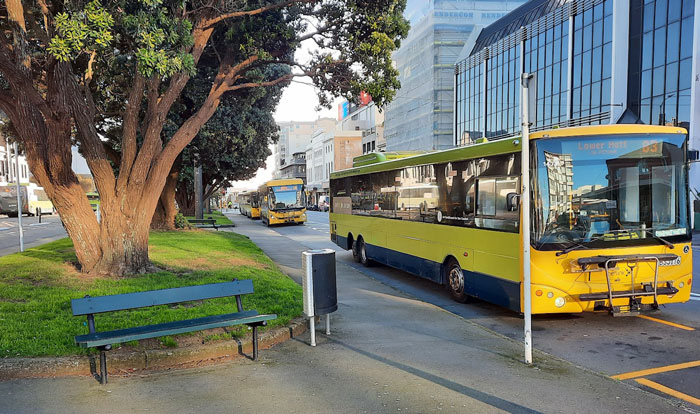
Benches and a rubbish bin are located back from this bus layover on Kent Terrace in Wellington, but the signpost is too close to the kerb. This may be why the bus shown has not fully pulled in. (Source: Lorelei Schmitt)
Off-street layover spaces are characterised by a separate off-road parking area dedicated to out of-service buses.
Key considerations for off-street layovers are:
-
Duration: generally used in situations when there are long layovers.
-
Capacity: often such facilities are designed to accommodate a high number of terminating buses which is useful where kerb space is limited, such as in city or town centres.
-
Facilities: it is often easier to provide more extensive driver facilities compared to on-street layovers because there may be more space and less conflict with street frontages.
-
Amenity/development integration: good urban amenity outcomes are typically best achieved when an off-street layover is integrated into a wider development, with other land uses or a public transport interchange.
-
Cost: off-street bus layovers generally have higher costs than on-street bus layovers. This is because additional land may need to be purchased or leased for off-street bus layovers whereas road control authorities typically already control the road space used by on-street bus layovers. However, off-street layovers may provide operating cost savings due to less out of service running and potentially lower peak vehicle or driver requirements. Public transport contracting authorities and/or road controlling authorities should undertake a holistic cost analysis which includes both the potential costs and likely benefits when considering which type of bus layover to choose.
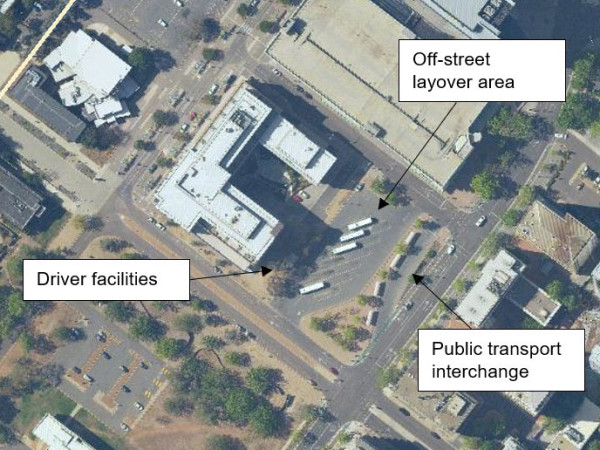
Example of off-street bus layover area (Source: ACT Government).
Potential quantifiable benefits and costs of off-street layovers:
|
Potential quantifiable benefits
|
Potential quantifiable costs
|
- Reduced out of service running
- Lower peak vehicle or driver requirements
- Improved service reliability if buses are being delayed whilst out of service
- Reduced number of driver facilities required
- Revenue from increase in paid on-street parking spaces
- Provides greater opportunity for e-charging
|
- Land purchase or rent
- Design and construction
- Operating costs such as utilities and insurance
- Asset maintenance and renewals
|
On-street bus layovers are characterised by designated on-street parking spaces for out of service buses.
Key considerations for on-street layovers are:
-
Duration: on-street layovers are typically used when the layover duration is only up to 30 minutes.
-
Capacity: usually suited to a limited number of terminating buses or where there is ample kerb space available.
-
Amenity: avoid streets with busy, active street frontages. There may be some benefits to street amenity by splitting up layover spaces rather than concentrating them to a hub. However, this might result in it being more difficult to provide driver facilities and could also result in a more out-of-service running.
-
Facilities: on-street layovers can be used for meal breaks where appropriate driver facilities are provided and where stationary buses would not obstruct in-service buses.
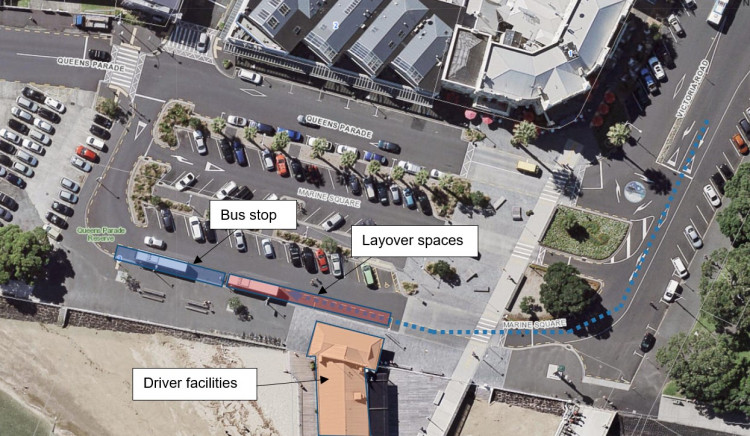
Example of on-street bus layover from Devonport, Auckland (Source: LINZ, NZTA, Eagle Technology).
Co-located or separated layoversBack to top
A bus layover space can either be co-located with the terminus bus stop or a separate layover space can be provided. The choice of where to locate the layover space depends on the characteristics of the services using the layover space as well as the requirements for workforce breaks.
It is best practice to separate the location of a layover space and a bus stop where possible and practical. A separate layover space allows the driver the opportunity to step away from their vehicle to take their break which may not be possible at co-located bus stops where passengers expect to be able to board and wait on the bus.
The decision-making flowchart below provides a general guide to determining whether a layover space can be located in a bus stop or not.
A general guide to selecting the type of layover space
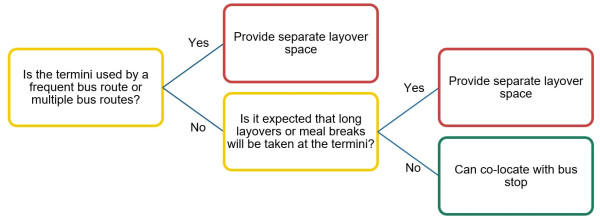
Guide to selecting whether an on-street layover can be co-located with a bus stop or not.
Follow these recommendations for co-located bus and layover stops:
- Layover must not be located at bus stops located on cycle lanes or across vehicle entrances and exits (Road User Rule 2004, sections 6.6 and 6.9)
- The Road User Rule 2004 requires that on-street layovers be designated and signed with bus parking, which can be time limited. This will also help reduce the risk of the space being used by other vehicles (such as private coaches).
- Provide sufficient overall length:
- The stop should be of sufficient length to enable buses to pull in and out independently without other buses needing to be moved.
- If the stop is designed to be used by more than one bus then the in-service buses should use the head of the stop and buses laying over should use the rear of the stop.
Follow these principles for separate layover spaces:
- The layover space: this should be a short distance from the commencement stop.
- Line of sight: ideally the bus driver should be able to see the commencement stop from the layover space to ensure it is clear before departing.
- Clearly defined spaces: the layover space should be in a less prominent location than the bus stop so that customers do not attempt to board from the layover space.
- Access: the layover space should be located for easy and safe access without complex manoeuvres; in the case of uncertainty use swept-path analysis and tracking.
Further information
For further information refer to the Land Transport (Road User Rule 2004), Sections 6.6, 6.9 and Definitions of ‘loading zone’ and ‘parking’:
Land Transport (Road User Rule 2004)(external link)
Further guidance on tracking and swept path analysis for buses:
Bus dimensions and tracking
A temporary layover is typically required when planning for a major event, such as construction projects or temporary service disruptions such as railway closures requiring bus replacement services. The temporary layover should be located as close as possible to the terminus stop and have enough capacity to accommodate the expected volume of terminating buses.
In establishing temporary layovers, engagement with key stakeholders such as bus operators and residents should be undertaken to ensure that operational needs are met whilst minimising any potential impacts.





